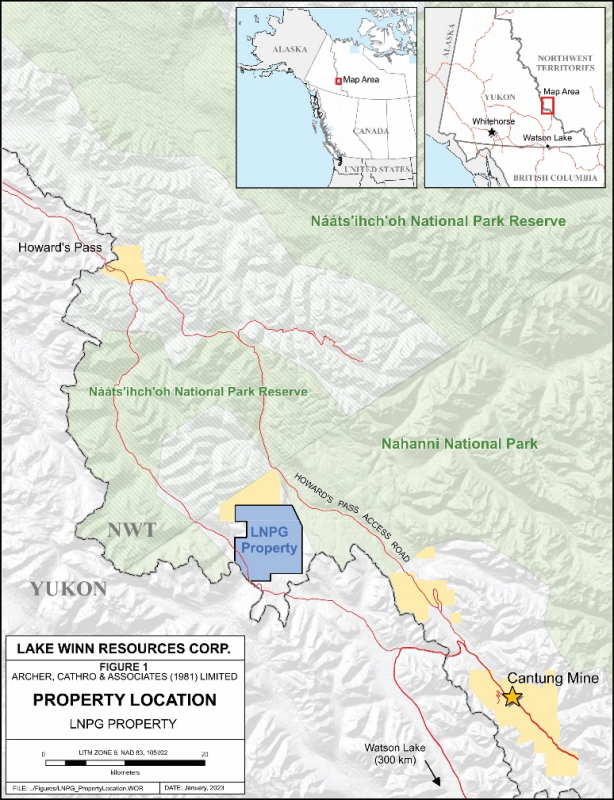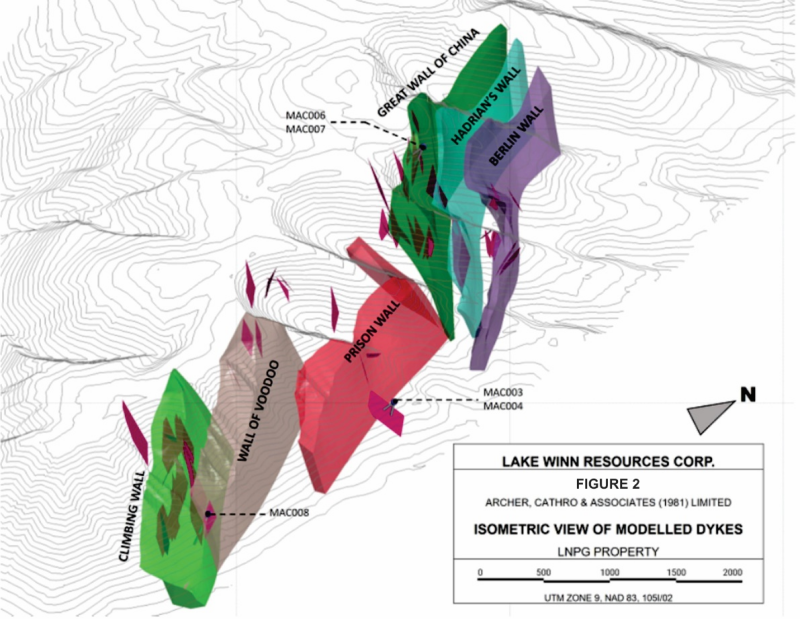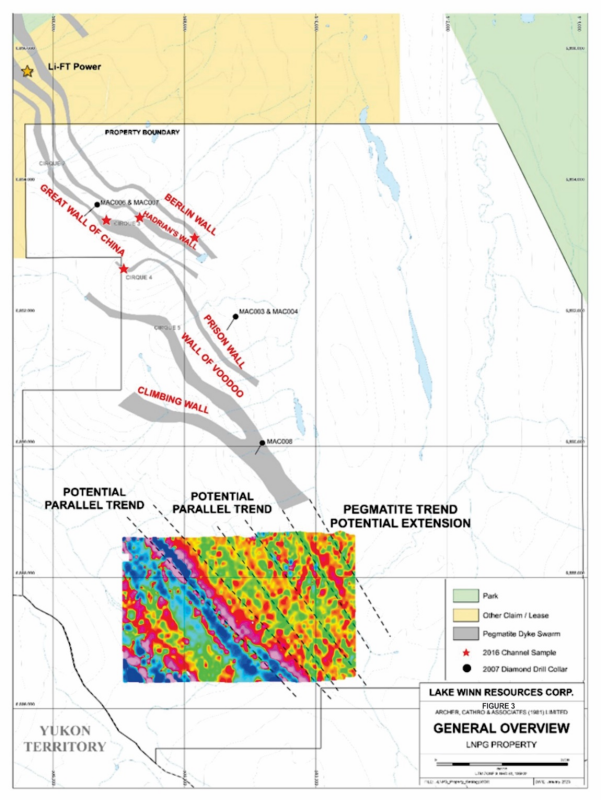Archive
Lake Winn Announces Completion of 3D Model of Pegmatite Dykes at Little Nahanni Lithium Project, Northwest Territories, Canada
 | |||||||||
 |  |  | |||||||
June 21st, 2023 – Vancouver, British Columbia – Lake Winn Resources Corp. (“Lake Winn” or the “Company”) (TSXV:LWR) (FSE:EE1A) is pleased to provide an update on recent activities related to its Little Nahanni Lithium Project (“the Project”) located in western Northwest Territories (NWT) as shown on Figure 1. The Project is 100% owned and covers 7,080 hectares of prospective ground.
The Little Nahanni Lithium Project was modelled by Archer, Cathro & Associates (1981) Limited at the request of Lake Winn to better define the pegmatite swarms in 3D and to assist in future exploration efforts on the Project. Data to date is insufficient to model for any purpose other than highlighting future exploration targets and trends.
The prospect comprises a series of dyke swarms which strike over 7,000 m along the extent of the claim group. Swarms range from 50 m to 250 m in width, with individual dykes typically 1-10 m wide. The dyke swarms dip steeply to the north-east and have been demonstrated in outcrop and drilling to have a vertical extent of 300 m or more.
Modelling was performed in Seequent Leapfrog Geo using surface mapping points and interpretations derived from previous exploration campaigns. Drill data, where possible, was incorporated in order to refine models and or add potential targets for further evaluation. Over 600 historical surface mapping points were used across the region to define the dyke swarms as well as model individual dykes. Classification and naming conventions were retained. Where local fault offsets were inferred from previous assessments, these were honoured as much as possible. Dip orientations were derived from surface mapping and projected to depth. The dykes remain open to depth and the full vertical extent of the dykes is unknown. They are modelled to an arbitrary depth, but this is not based on any current data apart from surface projections. Figure 2 illustrates an isometric view of modelled dykes.
Surface structural readings from mapping were used to generate individual dyke wireframes. These are 2D planes with arbitrary strike length and vertical extents and are primarily made to visually highlight dyke density and project strike extensions into data-sparse areas. Numerous lithology readings used to generate the dyke swarms have been collected across the property and can be further incorporated to define the dykes in greater resolution.
Surface data points for modelling are confined to ridges and other topographical highs which results in gaps of 500 m or more across cirques. Although continuity can be readily inferred where data points are dense, it is apparent that dyke complexity is high on a local scale and can affect volume estimates. Modelled dykes in these areas have inferred widths and orientations.
Work History
Historical drilling for tantalum in 2007 resulted in the initial lithium discoveries. Highlights from the historical drilling are shown in Table 1 and the drill hole locations are shown on Figure 2.
Table 1 – Historical Drill Highlights
|
DDH |
From (m) |
To (m) |
Width (m) |
Li2O (%) |
Ta2O5 (g/t) |
SnO2 (g/t) |
|
MAC001 |
62.50 |
63.60 |
1.10 |
0.05 |
722.4 |
697.9 |
|
MAC001 |
68.80 |
70.10 |
1.30 |
0.30 |
190.5 |
568.3 |
|
MAC001 |
86.00 |
89.20 |
3.20 |
0.54 |
76.9 |
384.8 |
|
MAC001 |
102.80 |
105.94 |
3.14 |
0.63 |
140.4 |
189.2 |
|
MAC001 |
121.60 |
122.10 |
0.50 |
0.07 |
610.5 |
401.3 |
|
MAC006 |
61.88 |
66.86 |
4.98 |
0.26 |
76.9 |
231.1 |
|
MAC006 |
85.60 |
87.00 |
1.40 |
0.65 |
316.6 |
531.9 |
|
MAC006 |
172.37 |
190.64 |
18.27 |
0.92 |
33.0 |
149.9 |
|
MAC007 |
30.22 |
33.62 |
3.40 |
0.20 |
57.4 |
171.5 |
|
MAC007 |
105.84 |
116.78 |
10.94 |
1.20 |
35.4 |
219.7 |
|
MAC007 |
143.73 |
149.20 |
5.47 |
0.33 |
26.9 |
104.1 |
|
MAC008 |
37.58 |
38.73 |
1.15 |
0.58 |
172.1 |
526.9 |
In 2017 the Company resampled the 2007 drill core as the previous property owner’s focus was on tantalum and tin and many of the 2007 samples exceeded the upper detection limit for lithium (1%) and were not further analyzed. The resampling highlights can be found in Table D.
Table D - Li2O Grade Comparison 2007 to 2017
|
DDH |
2007 Length (m) |
2007 Grade Li2O |
2017 Length (m) |
2017 Grade Li2O |
% Li2O Increase |
|
MAC006 |
18.27 |
0.92% |
17.96 |
1.03% |
12% |
|
MAC007 |
10.94 |
1.20% |
9.66 |
1.47% |
23% |
A channel sampling program was conducted on the Project in 2016 confirming the grade and tenor of the lithium occurrences at surface (Table 2).
Table 2 – Channel Sampling Results
|
Dyke Swarm |
Width (m)*1 |
Li2O (%) |
Ta2O5 (g/t) |
SnO2 (%) |
|
Prison Wall |
4.40 |
1.12 |
55.0 |
0.05 |
|
1.20 |
2.33 |
59.0 |
0.05 |
|
|
1.90 |
0.87 |
56.4 |
0.03 |
|
|
1.70 |
1.57 |
250.3 |
0.95 |
|
|
Berlin Wall |
4.00 |
2.04 |
57.8 |
0.05 |
|
1.95 |
2.29 |
48.7 |
0.01 |
|
|
0.95 |
3.10 |
53.6 |
0.03 |
|
|
Great Wall of China |
16.65 |
1.21 |
65.4 |
0.03 |
|
3.75 |
1.67 |
45 |
0.03 |
|
|
7.00 |
1.41 |
59.9 |
0.04 |
|
|
1.25 |
1.83 |
67.3 |
0.05 |
|
|
5.15 |
1.63 |
52.9 |
0.01 |
|
|
Hadrian's Wall |
1.05 |
0.85 |
80.9 |
0.05 |
|
6.30 |
1.86 |
116.7 |
0.05 |
*1 – Measured widths are estimated to be 98 to 90% of the true thickness, due to the near vertical dip.
Dias Geophysical Limited (“Dias”) recently completed a QMAGT airborne geophysical survey across the property. The survey involved flying 512 line-kilometers with minimum lengths of 3 km and line spacings of 75 m. Flight line directions were oriented at 090°. The QMAGT system used is a full-tensor magnetic gradiometry system employing the SQUID (superconducting quantum interface device) sensor. Figure 3 below illustrates preliminary data from the geophysical survey. The survey was conducted over 6 days in December 2022 based out of Watson Lake, Yukon.
Engagement with Nahʔą Dehé Dene Band
Company CEO, Patrick Power, and VP Exploration, Buddy Doyle, travelled to Nahanni Butte, Northwest Territories on May 24th to meet with the Nahʔą Dehé Dene Band (NDDB). The day involved a presentation and discussions regarding the Little Nahanni Lithium Project.
“I’m encouraged with Lake Winn’s first-ever visit to the community of Nahanni Butte. We had a wonderful introductory meeting with NDDB and we look forward to continuing to grow the relationship between Lake Winn and NDDB. I would like to thank Chief Steve Vital and his team for their time and for hosting us in their beautiful community.” - Patrick Power, CEO
The technical information in this news release has been approved by Heather Burrell, P.Geo., a senior geologist with Archer, Cathro & Associates (1981) Limited and a qualified person for the purpose of National Instrument 43-101.
About Lake Winn Resources
Lake Winn Resources Corp. is a mineral exploration company focused on advancing its 100% owned Little Nahanni Lithium Project (“LNLP”), which is located in the western Northwest Territories near the Yukon Border. The project covers 7,080 hectares that encompasses a 7 km long, and up to 500 m wide, lithium, tantalum, and tin pegmatite dyke swarm. Historical drilling and channel sampling on the Project confirms the presence of significant lithium, tantalum, and tin.
The Company was recently issued a 5-year Class-A Permit to conduct exploration on the Project. The permit is inclusive of camp construction, drilling, trenching, and channel sampling (see Press Release date May 9th, 2023).
ON BEHALF OF THE BOARD OF DIRECTORS OF LAKE WINN RESOURCES CORP.
Patrick Power, President & CEO
+1 (604) 218-8772
www.lakewinn.ca
Neither the TSX Venture Exchange nor its Regulation Services Provider (as that term is defined in the policies of the TSX Venture Exchange) accepts responsibility for the adequacy or accuracy of this release.
Cautionary Statement Regarding “Forward-Looking” Information
This news release contains “forward-looking statements” including but not limited to statements with respect to Lake Winn’s plans, the estimation of a mineral resource, and the success of exploration activities. In this release, it is not certain if the discovery will be economic or not as this depends on many factors. Forward-looking statements, while based on management’s best estimates and assumptions, are subject to risks and uncertainties that may cause actual results to be materially different from those expressed or implied by such forward-looking statements. There can be no assurance that such statements will prove to be accurate, as actual results and future events could differ materially from those anticipated in such statements. Factors that could affect our plans include our potential inability to raise funds as intended, and in such event, we may require all funds raised, if any, to be used for working capital rather than the intended uses as outlined. Accordingly, readers should not place undue reliance on forward‐looking statements. Lake Winn undertakes no obligation or responsibility to update forward‐looking statements, except as required by law.


